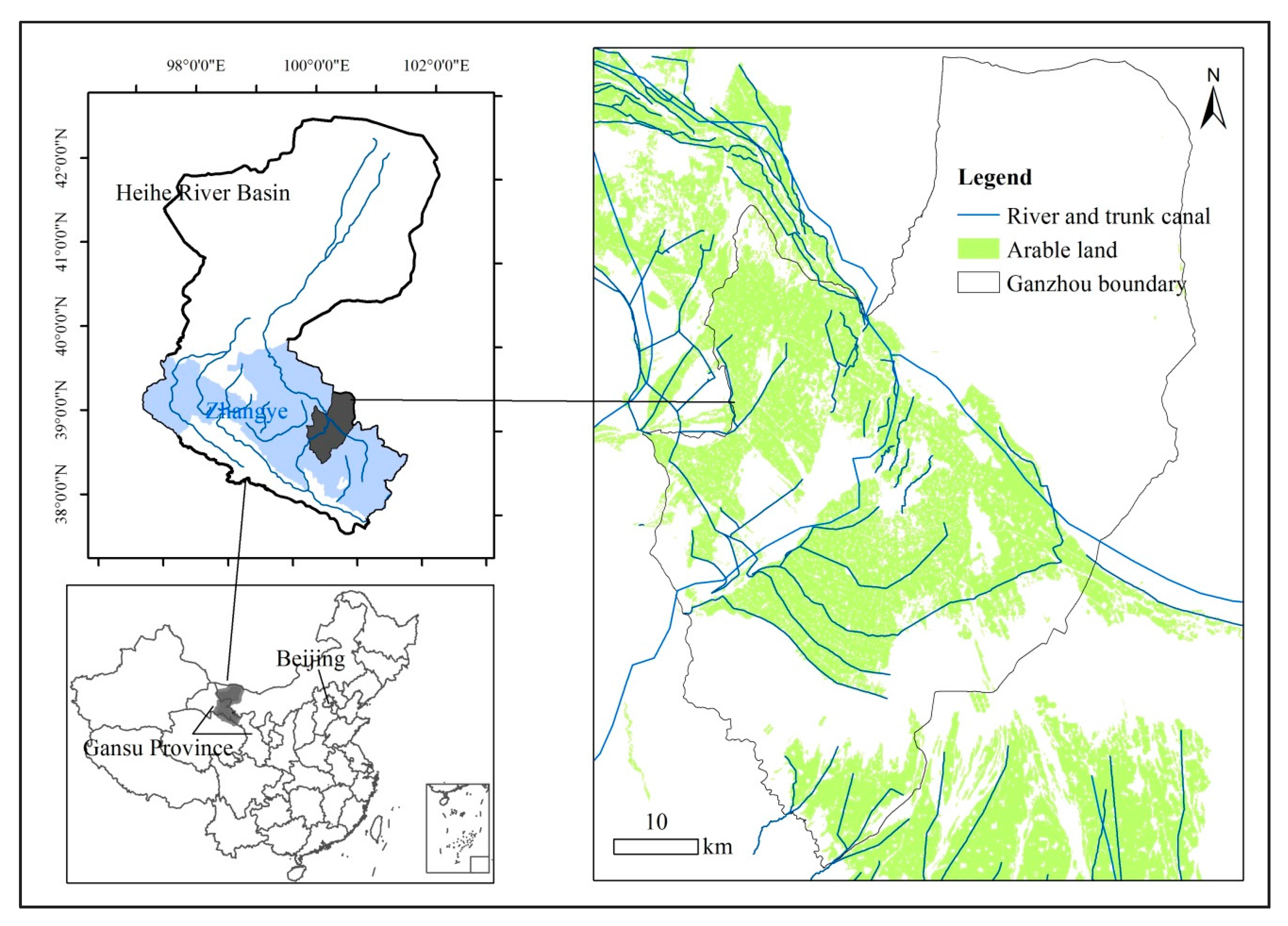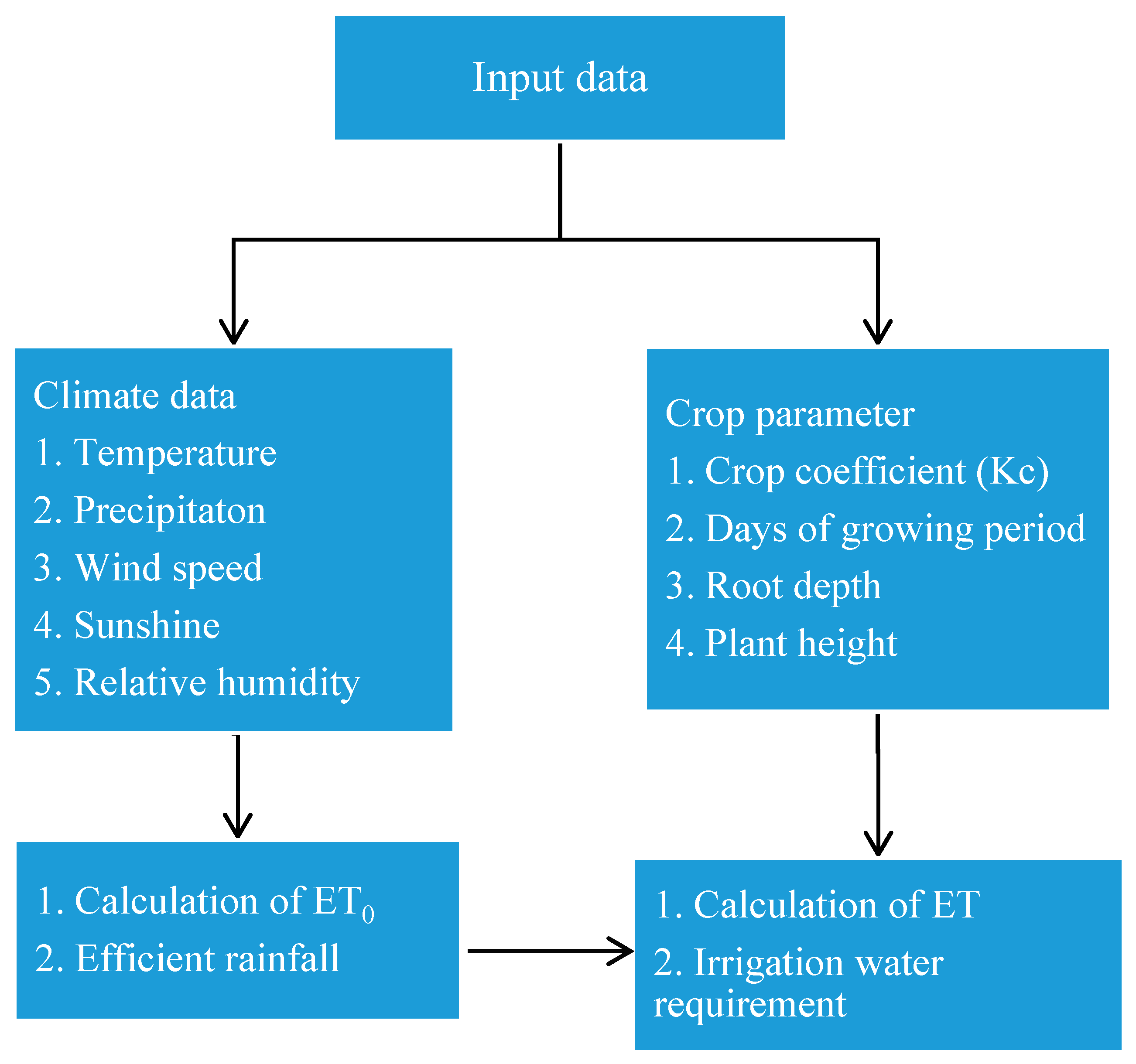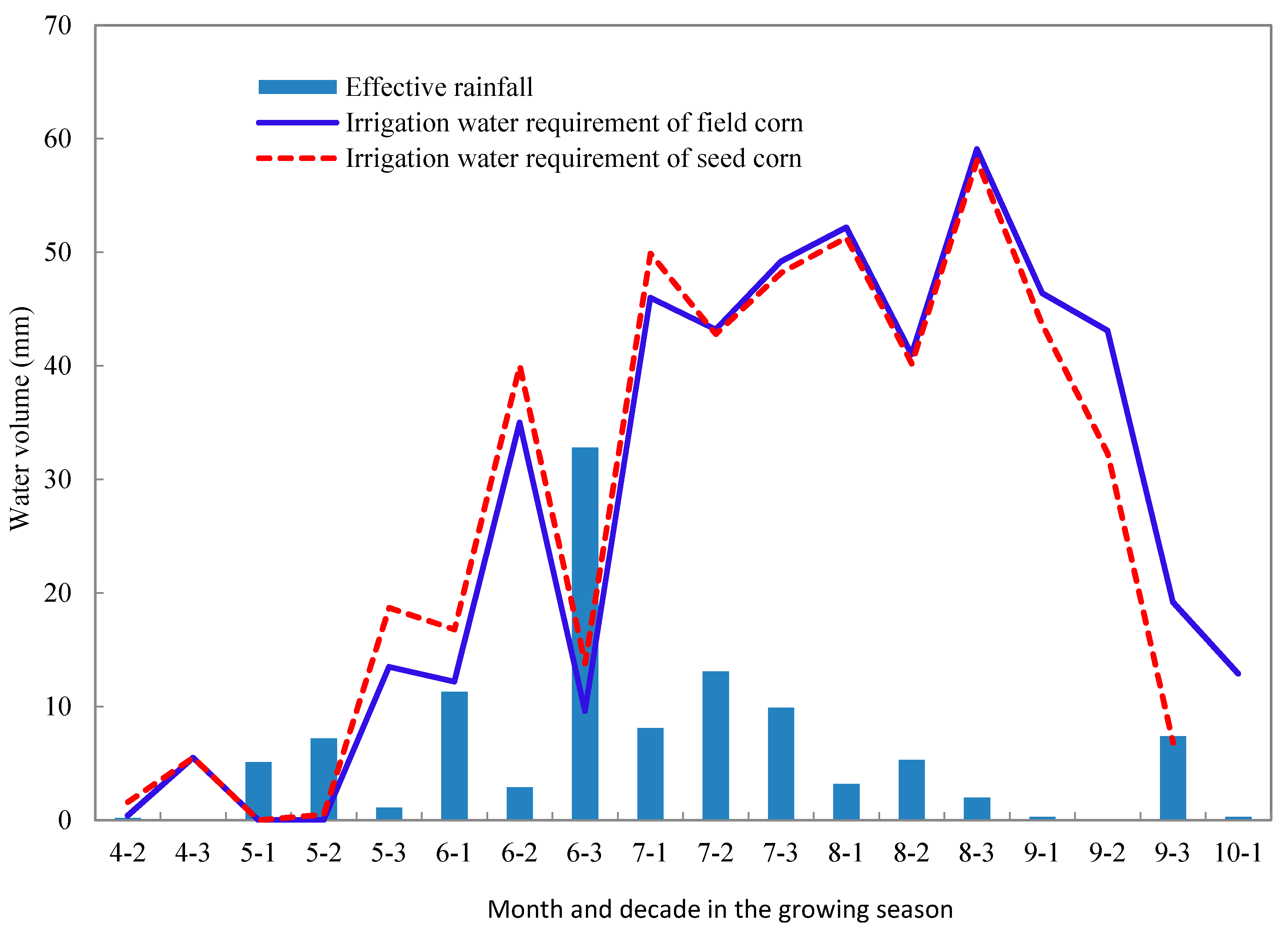Different Irrigation Water Requirements of Seed Corn and Field Corn in the Heihe River Basin
Abstract
:1. Introduction
2. Materials and Methods
2.1. Data Sources and Data Processing
2.2. Research Methods
2.2.1. Introduction of the CROPWAT Model
2.2.2. Calculation of the Reference ET
2.2.3. Calculation of the ET of the Crop
2.2.4. Calculation of Effective Rainfall and Irrigation Water Requirement
2.2.5. The ET Measurements
3. Results and Discussion
3.1. Simulation and Verification of Corn Evapotranspiration
3.2. Variation Rules of Irrigation Water Requirement of Corn
3.3. Differences in Irrigation Water Requirement of Seed Corn and Field Corn
4. Conclusions
Acknowledgments
Author Contributions
Conflicts of Interest
References
- Tanji, K.K.; Kielen, N.C. Agricultural Drainage Water Management in Arid and Semi-Arid Areas; Food and Agriculture Organization of the United Nations: Rome, Italy, 2002; pp. 1–205. [Google Scholar]
- Wang, G.F.; Chen, J.C.; Wu, F.; Li, Z.H. An integrated analysis of agricultural water-use efficiency: A case study in the Heihe River Basin in Northwest China. Phys. Chem. Earth 2015, 89–90, 3–9. [Google Scholar] [CrossRef]
- Hamdy, A.; Ragab, R.; Scarascia-Mugnozza, E. Coping with water scarcity: Water saving and increasing water productivity. Irrig. Drain. 2003, 52, 3–20. [Google Scholar] [CrossRef]
- Sun, T.H.; Wang, J.X.; Huang, Q.Q.; Li, Y.R. Assessment of water rights and irrigation pricing reforms in Heihe River Basin in China. Water 2016, 8, 333. [Google Scholar] [CrossRef]
- Huang, Q.Q.; Wang, J.X.; Li, Y.M. Do water saving technologies save water? Empirical evidence from North China. J. Environ. Econ. Manag. 2017, 82, 1–16. [Google Scholar] [CrossRef]
- Masafu, C.K.; Trigg, M.A.; Carter, R.; Howdend, N.J.K. Water availability and agricultural demand: An assessment framework using global datasets in a data scarce catchment, Rokel-Seli River, Sierra Leone. J. Hydrol. Reg. Stud. 2016, 8, 222–234. [Google Scholar] [CrossRef]
- Zheng, X.; Zhu, J.J.; Yan, Q.L.; Song, L.N. Effects of land use changes on the groundwater table and the decline of Pinus sylvestris var. mongolica plantations in southern Horqin Sandy Land, Northeast China. Arg. Water Manag. 2012, 109, 94–106. [Google Scholar] [CrossRef]
- Li, J.; Zhu, T.; Mao, X.M.; Adeloye, A.J. Modeling crop water consumption and water productivity in the middle reaches of Heihe River Basin. Comput. Electron. Agric. 2016, 123, 242–255. [Google Scholar] [CrossRef]
- Uddin, J.; Hancock, N.H.; Smith, R.J.; Foley, J.P. Measurement of evapotranspiration during sprinkler irrigation using a precision energy budget (Bowen ratio, eddy covariance) methodology. Agric. Water Manag. 2013, 116, 89–100. [Google Scholar] [CrossRef]
- Zhuang, Q.F.; Wu, B.F. Estimating evapotranspiration from an improved two-source energy balance model using ASTER satellite imagery. Water 2015, 7, 6673–6688. [Google Scholar] [CrossRef]
- Li, S.; Kang, S.Z.; Zhang, L.; Zhang, J.H.; Du, T.S.; Tong, L.; Ding, R.S. Evaluation of six potential evapotranspiration models for estimating crop potential and actual evapotranspiration in arid regions. J. Hydrol. 2016, 543, 450–461. [Google Scholar] [CrossRef]
- Li, X.M.; Lu, L.; Yang, W.F.; Cheng, G.D. Estimation of evapotranspiration in an arid region by remote sensing—A case study in the middle reaches of the Heihe River Basin. Int. J. Appl. Eart Obs. Geoinf. 2012, 17, 85–93. [Google Scholar] [CrossRef]
- Luo, X.; Wang, K.; Jiang, H.; Sun, J.; Zhu, Q. Estimation of land surface evapotranspiration over the Heihe River basin based on the revised three-temperature model. Hydrol. Process 2012, 26, 1263–1269. [Google Scholar] [CrossRef]
- Jarchow, C.J.; Nagler, P.L.; Glenn, E.P.; Ramírez-Hernandez, J.; Rodríguez-Burgueño, E. Evapotranspiration by remote sensing: An analysis of the Colorado River Delta before and after the Minute 319 pulse flow to Mexico. Ecol. Eng. 2016. [Google Scholar] [CrossRef]
- Land and Water Development Division of Food and Agriculture Organization (LWD-FAO). 2009. Available online: http://www.fao.org/land-water/databases-and-software/cropwat/en/ (accessed on 18 March 2013).
- Zhangye’s Statistical Bureau. Zhangye’s Statistical Yearbook in 2012; Zhangye’s Statistical Bureau: Zhangye, China, 2012. [Google Scholar]
- Chen, Y.; Zhang, D.Q.; Sun, Y.B.; Lin, X.N.; Wang, N.Z.; Savenije, H.H.G. Water requirement management: A case study of the Heihe River Basin in China. Phys. Chem. Earth 2005, 30, 408–419. [Google Scholar] [CrossRef]
- Yang, B.; Wen, X.F.; Sun, X.M. Irrigation depth far exceeds water uptake depth in an oasis cropland in the middle reaches of Heihe River Basin. Sci. Rep. 2015, 5. [Google Scholar] [CrossRef] [PubMed]
- Wang, J.F.; Gao, Y.C.; Wang, S. Land use/cover change impacts on water table change over 25 years in a desert-oasis transition zone of the Heihe River Basin, China. Water 2016, 8, 11. [Google Scholar] [CrossRef]
- Chai, Q.; Gan, Y.T.; Turner, N.C.; Zhang, R.Z.; Yang, C.; Niu, Y.N.; Siddique, K.H.M. Water-saving innovations in Chinese agriculture. Adv. Agron. 2014, 126, 149–201. [Google Scholar] [CrossRef]
- Zhao, L.W.; Zhao, W.Z.; Ji, X.B. Division between transpiration and evaporation, and crop water consumption over farmland within oases of the middlestream of Heihe River basin, Northwestern China. Acta Ecol. Sin. 2015, 35, 1114–1123. [Google Scholar] [CrossRef]
- Li, D.S.; Ji, X.B.; Zhao, L.W. Simulation of seed corn farmland soil moisture migration regularity in the midstream of the Heihe River Basin. Arid Zone Res. 2015, 32, 467–475. [Google Scholar] [CrossRef]
- Allen, R.G.; Pereira, L.S.; Raes, D.; Smith, M. FAO Irrigation and Drainage Paper No. 56; Food and Agriculture Organization of the United Nations: Rome, Italy, 1998. [Google Scholar]
- Liu, S.M.; Xu, Z.W.; Zhao, Q.Y.; Xu, T.R.; Ge, Y.; Ma, Y.F.; Song, L.S.; Zhu, Z.L.; Jia, Z.Z.; Zhang, F. Upscaling evapotranspiration measurements from multi-site to the satellite pixel scale over heterogeneous land surfaces. Agric. For. Meteorol. 2016, 230–231, 97–113. [Google Scholar] [CrossRef]
- Xu, Z.W.; Liu, S.M.; Li, X.; Shi, S.J.; Wang, J.; Zhu, Z.L.; Xu, T.R.; Wang, W.Z.; Ma, M.G. Intercomparison of surface energy flux measurement systems used during the HiWATER-MUSOEXE. J. Geophys. Res-Atmos. 2013, 118, 13140–13157. [Google Scholar] [CrossRef]
- Liu, S.M.; Xu, Z.W.; Wang, W.Z.; Jia, Z.Z.; Zhu, M.J.; Bai, J.; Wang, J.M. A comparison of eddy-covariance and large aperture scintillometer measurements with respect to the energy balance closure problem. Hydrol. Earth Syst. Sci. 2011, 15, 1291–1306. [Google Scholar] [CrossRef]
- Wolf, A.; Saliendra, N.; Akshalov, K.; Johnson, D.A.; Laca, E. Effects of different eddy covariance correction schemes on a energy balance closure and comparisons with the modified Bowen ratio system. Agric. For. Meteorol. 2008, 148, 942–952. [Google Scholar] [CrossRef]
- Shi, T.T.; Guan, D.X.; Wu, J.B.; Wang, A.Z.; Jin, C.J.; Han, S.J. Comparison of methods for estimating evapotranspiration rate of dry forest canopy: Eddy covariance, Bowen ratio energy balance, and Penman-Monteith equation. J. Geophys. Res-Atmos. 2008, 113. [Google Scholar] [CrossRef]
- Li, Z.S.; Jia, L.; Hu, G.C.; Lu, J.; Zhang, J.; Chen, Q.T.; Wang, K. Estimation of growing season daily ET in the middle stream and downstream areas of the Heihe River Basin using HJ-1 data. IEEE Geosci. Remote Sens. Lett. 2015, 12, 948–952. [Google Scholar]
- Zhao, L.W.; Ji, X.B. Quantification of transpiration and evaporation over agricultural field using the FAO-56 dual crop coefficient approach-A case study of the maize field in an oasis in the middlestream of the Heihe River Basin in northwest China. Sci. Agric. Sin. 2010, 43, 4016–4026. [Google Scholar]
- Wu, J.K.; Ding, Y.J.; Wang, G.X.; Yamazaki, Y.; Kubota, J. Evapotranspiration of seed maize field in arid region. J. Irrig. Drain. 2007, 26, 14–17. [Google Scholar]
- Shi, M.J.; Wang, L.; Wanng, X.J. A study on changes and driving factors of agricultural water supply and demand in Zhangye after water reallocation of the Heihe River. Resour. Sci. 2011, 33, 1489–1497. [Google Scholar]





| Crop | Sowing Date | Length of the Growth Stage (Days) | Root Depth (m) | Plant Height (m) | ||||
|---|---|---|---|---|---|---|---|---|
| Initial Growth Stage | Rapid Growth Stage | Middle Growth Stage | End Growth Stage | Initial Root Depth | Grown Root Depth | |||
| Seed corn | 15 April | 30 | 56 | 57 | 21 | 0.6 | 1.5 | 1.8 |
| Field corn | 20 April | 30 | 56 | 67 | 21 | 0.6 | 2.3 | 2.5 |
| Crop Types | Crop Coefficients | ||
|---|---|---|---|
| Kcini | Kc mid | Kc end | |
| Seed corn | 0.1 | 1.02 | 0.56 |
| Field corn | 0.1 | 1.03 | 0.38 |
© 2017 by the authors. Licensee MDPI, Basel, Switzerland. This article is an open access article distributed under the terms and conditions of the Creative Commons Attribution (CC BY) license (http://creativecommons.org/licenses/by/4.0/).
Share and Cite
Tan, M.; Zheng, L. Different Irrigation Water Requirements of Seed Corn and Field Corn in the Heihe River Basin. Water 2017, 9, 606. https://doi.org/10.3390/w9080606
Tan M, Zheng L. Different Irrigation Water Requirements of Seed Corn and Field Corn in the Heihe River Basin. Water. 2017; 9(8):606. https://doi.org/10.3390/w9080606
Chicago/Turabian StyleTan, Minghong, and Luqian Zheng. 2017. "Different Irrigation Water Requirements of Seed Corn and Field Corn in the Heihe River Basin" Water 9, no. 8: 606. https://doi.org/10.3390/w9080606




